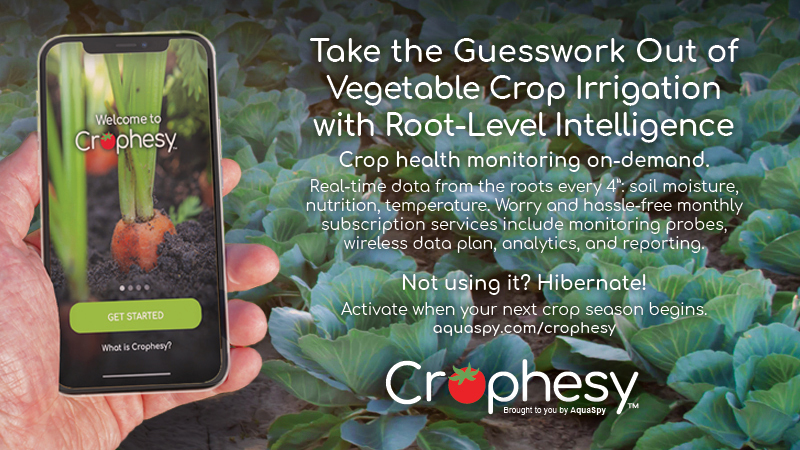Florida Tomato Industry At A Crossroads

The numbers tell the story of the challenges facing the Florida tomato industry. In 2004-2005, the state’s growers planted 45,200 acres of the crop. Only a few years later in 2010-2011, the state’s acres had dropped sharply to 32,000 acres.
While there’s a number of reasons behind the falling numbers, most would agree that the state’s industry is at a crossroads. One path follows that of continued sustainability of one of Florida’s signature crops, and the other is not so pleasant to fathom. Any way you slice it, the tomato industry is in a period of major change — its growers being buffeted by many outside forces.
New Competition
One of the most significant factors that has impacted Florida and U.S. tomato growers in recent years has been an influx of tomatoes from Mexico, particularly in the retail sector.
Reggie Brown, executive vice president of the Florida Tomato Growers Exchange, paints a stark picture of the state’s tomato industry if imports continue at the pace of recent years. “The current situation is destroying the domestic tomato industry all the way across this country,” he says. “Yes, if we’ve become obsolete and not competitive, then we get what we deserve. But, we believe strongly that we are being impacted by unfair competition, so it is time that we draw a line in the sand. There are rules and processes in place to deal with that.”
Those rules and processes include a suspension agreement with Mexican producers from a 1996 dumping case. A suspension agreement is an arrangement entered into by the guilty party — in this case Mexico — with U.S. Department Of Commerce to suspend the antidumping case. In courts, it would be similar to a plea agreement. The agreement set a floor price for winter tomatoes (21.69¢ per pound) and a summer price (17.2¢ per pound) that Mexico must not sell below into the U.S.
“We have recorded numerous quotes of prices below the reference price in terminal markets and marketing eMails,” says Brown “The opportunities to circumvent the reference price are only limited by the degree of imagination that the sellers have.”
Florida’s biggest beef with the current suspension agreement is it is based on data that is 16 years old from when the antidumping case was brought. “The floor price was adjusted in 2003,” says Brown. “We’ve always petitioned them to adjust the floor price, but Mexican officials have never been interested in doing this.”
The old data doesn’t reflect the change in production in Mexico and current realities faced by U.S. growers. One of those realities is sharply higher costs of production, which have made margins razor thin for Florida producers.
“Our cost of production has gone from approximately $5,000 per acre to approximately $10,000 over a period of about 10 years,” says Tony DiMare, vice president of DiMare Co. “Anytime costs go up in our business as growers of fresh produce, those increased costs eat into our margins because we don’t have the ability to add the increased costs to our goods.”
With these production costs generally doubling, the break-even price for growers is about $10 per 25-pound carton. Growers know too well the bust and boom cycle in the past several years, which have seen prices bust more often and earlier.
Mexican trade officials have lodged a protest against Florida’s petition to remove the suspension agreement. But, Brown notes the case will be entirely removed if Florida’s petition were to succeed, leaving no protection at all on imports.
“Our whole push has been to No. 1 get away from the old case and its data,” he says. “And, No. 2, have the ability defend our rights under U.S. trade law, if today’s data and facts warrant it.”
Many U.S. lawmakers on the state and federal level have written letters to the Department of Commerce in support of Florida’s effort to remove the case.
→[UPDATE]: On Sept. 27, the U.S. Department of Commerce took action and preliminarily agreed to terminate the suspension agreement. The Department said a final decision on the U.S./Mexican agreement will be reached in about 9 months. Reports indicate removing this agreement will clear the way for U.S. growers to seek a new antidumping case.
Changes In Production And Demand
According to Brown, approximately 70% of Florida’s open field production goes into the foodservice industry and most all of its Roma production goes there. Grape tomato production goes into the foodservice and retail chain.
“Our business has always been very competitive,” says DiMare. “What’s happened in the tomato business is you’ve had a shift in diversification with production moving more and more to protected culture (greenhouse, shade, and high tunnel), which has created a shift in buying practices primarily at the retail level to source more greenhouse product. This in turn has caused market share loss for growers who produce open field product. Unfortunately, greenhouse production is not viable in Florida due to expensive infrastructure costs and a non-conducive growing environment.”
In Mexico, the changes in production have been just as dramatic as the sharply increasing costs of production for U.S. producers. In the past decade, there has been a dramatic increase in greenhouse production.
According to Sagarpa (Mexico’s Agriculture Department), 50,000 acres of vegetable crops were produced in protected agriculture in 2012. Greenhouses made up 30,000 acres of this total and the remaining 20,000 acres were shadehouses and high tunnels. Tomatoes make up 70% of the vegetable crops produced under cover in Mexico. Of all the Mexican tomatoes imported into the U.S. in 2011, 39% of them were grown in greenhouses. A decade ago, only 5% of Mexican tomato imports were greenhouse grown.
Florida Tomato Industry At A Crossroads ctd.

This dramatic shift indicates a change in U.S. retail buyers’ perceptions of the imported product, according to John VanSickle, an agricultural economist at UF/IFAS. He says for years, retailers were suspect of product coming in from Mexico because of food safety and chemical residue concerns. But, with those concerns exposed, they changed their production system to address them.
“The U.S. retailers have bought into what they [Mexico] are doing and are perfectly comfortable with the product,” says VanSickle. “That is where a large part of the market has changed and we in Florida have lost part of our niche.”
Finding A Niche
The success of the Tasti-Lee tomato in the retail market has demonstrated that a field grown tomato can find a place on retail shelves. The flavorful, deep-red tomato has made a big splash with consumers. The variety was bred at the Gulf Coast Research and Education Center and is now marketed by Bejo Seeds. It was bred with a flavor-first approach, but retained a firmness to produce a good range of marketable fruit.
Bejo has partnered with a number of growers who can supply the tomato to retailers in a manner that meets the variety’s expectations. The partnership is paying off — the Tasti-Lee is in all 1,100 Publix stores and is expanding into all Kroger divisions east and west.
Lipman, the largest open field producer in North America, has been making headway with its brand, the Vintage Ripe. “While this tomato is not the largest segment by far of what we grow, it is our fastest growing category,” says Kent Shoemaker, CEO of Lipman. “Quite frankly, we’ve had trouble keeping up with demand for the tomato.”
The Vintage Ripe is a field grown tomato that is harvested at a higher color and scores with greater sugars and acids. It also requires more handling and labor to meet specifications.
“You know greenhouse grown is not necessarily synonymous with flavor,” says Shoemaker. “We still believe that nature and the sun grow the best tasting crops.”
So confident in its flavor, Lipman recently offered consumers a free taste test of a limited supply of the Vintage Ripes at TrueTomatoTaste.com.
Both the Tasti-Lee and Vintage Ripe illustrate the importance of branding and marketing of specific types of tomatoes based upon their taste and quality. This will require a long-term commitment and the development of new relationships between growers and marketers alike to further develop these niche tomatoes.
A New Model
Given the market challenges and tight profit margins, VanSickle contends it already is past a point where smaller growers can compete. “There is just way too much risk in the mature green production market for smaller growers,” he says. “They will have to figure out a way to get into the retail market. The smaller grower has an opportunity if he or she can develop a vine-ripe type of product and tap into the buy local movement.”
“There are the smaller producers who are having success with the Tasti-Lee and vine ripes as their primary production,” adds Brown. “Some are growing grape tomatoes, so there are a lot of different niches to be found out there. There is opportunity for different strategies in this marketplace. While some of these niche markets are not as broad and deep as a traditional market, they may well be sufficient to support smaller growers.”
However, in larger-scale systems, DiMare believes harvesting higher color tomatoes presents challenges in Florida. “At one time, Florida had a large vine-ripe industry, but due to adverse weather — primarily rain and rain effects — many growers went out of business due to a lack of production and quality issues,” he says. “The other concern is having adequate labor to harvest tomatoes with more color. This requires a much larger workforce to keep up with the production. Also, the cost to harvest vine-ripe crops is a lot more expensive.”
The Road Forward
Brown says the outcome of the trade challenge with Mexico is a defining moment not just for Florida’s tomato industry, but also for other commodity groups in the future. “I’ve been talking to tomato growers all over the country in the past few weeks,” he says. “I have assured them this is not just a Florida issue, but a national one. Additionally, I can assure you that if you stay in this business for another 10 years, there will be numerous commodities wishing they had the ability to organize and challenge competitors as we are trying to do now.”










